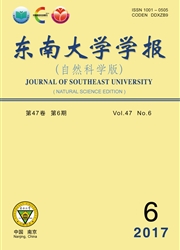

 中文摘要:
中文摘要:
利用SEM-BSE成像模式和EDS-Mapping模式测试了质量分数为2.5%和5.0%Na2SO4溶液侵蚀1年后的水泥净浆、砂浆试样的微观形貌和元素分布.结合图像分析方法,定量描述与分析了试样中硫元素浓度分布规律及硫酸根离子的侵蚀深度.结果表明:不同浓度Na2SO4溶液侵蚀下的净浆、砂浆试样中硫元素浓度分布趋势基本一致,表层浆体硫元素浓度较低,近表层区出现高硫含量带,随后硫元素浓度随深度增加而下降,下降幅度先剧烈后平缓,最终硫元素浓度趋于稳定.硫元素各分布段分别对应于石膏集中生成区、石膏与钙矾石混合生成区、钙矾石集中生成区以及未腐蚀区.高浓度Na2SO4溶液侵蚀后的净浆试样的高硫含量带宽度为550μm,硫元素浓度峰值为6.87%,明显大于低浓度Na2SO4溶液侵蚀后的试样(分别为300μm和1.93%);低浓度Na2SO4溶液侵蚀下,砂浆试样高硫含量带宽度大于同水灰比净浆试样,硫元素浓度峰值略小于净浆试样.
 英文摘要:
英文摘要:
Backscattered electron image and mapping mode of EDS were adopted to test microstructure and element distributions in cement pastes and mortars eroded by 2.5% and 5.0% Na2SO4 solutions for one year.Combined with subsequent image processing,the distribution rules of sulfur were quantitatively described and analyzed.The results show that the sulfur distribution trends in specimens are basically consistent.The sulfur content in the surface paste is low,"high sulfur content" band appears in the near-surface zone,subsequently,with the increase of depth,sulfur content firstly decreases significantly,then decreases gradually,finally tends to a constant.These sulfur distribution segments correspond to the gypsum area,gypsum-ettringite coexistence area,ettringite area and not eroded area,respectively.Moreover,the width and peak concentration of "high sulfur content" band of cement pastes immersed in 5.0% Na2SO4 solution are 550μm and 6.87%,greater than those in 2.5% Na2SO4 solution(300μm and 1.93%,respectively),and the width of "high sulfur content" band of cement mortar immersed in 2.5% Na2SO4 solution is greater than that of cement paste.
 同期刊论文项目
同期刊论文项目
 同项目期刊论文
同项目期刊论文
 期刊信息
期刊信息
